Yet Ljubljana isn't just for looking at – it's a living, thriving place, with several major summer music and performing arts festivals, dozens of theatres, museums and galleries, and a bright array of cafes, bars, pubs and clubs kept hopping by a big student population. Dividing downtown in two, the Ljubljanica River helps make city life a little more sane, and its colorful embankments feature dozens of outdoor restaurants and watering holes, numerous small shops, a weekly flea market, and lots of space for promenading. And you'll never forget you're in the middle of Europe's greenest country: Ljubljana has plenty of parks and gardens, even three forested hills right within city limits, and both the Alps and the Adriatic are just two hours or less away. So any fear you've had of being bored in some obscure ex-provincial capital will be instantly, delightfully dispelled.
 Bishop's Palace and the Seminary
Bishop's Palace and the Seminary
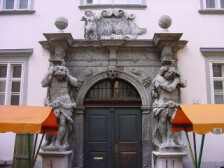
These two grand edifices flank the Cathedral to the west and north, respectively. The Bishop's Palace dates from the Renaissance, but its present form, featuring a beautiful inner courtyard and loggia, comes from the 18th century. Besides church dignitaries, Napoleon and other European emperors have rested their heads here, and the French governors of the province of Illyria also resided in the palace. The Seminary is likewise from the 18th century, and contains a priceless library. The big, dumb, lionskin-clad giants lurking in its doorway on Dolničarjeva Street are the work of Andrea Pozzo.
 Dragon Bridge
Dragon Bridge
 The Marketplace
The Marketplace
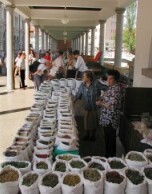
Ljubljana's vast, colorful market area (open daily except Sundays) spreads out across two open lots (Pogačarjev trg and Vodnikov trg), with a flower market in between them, running alongside the Cathedral and Seminary. There are bakery, dairy and meat stalls on the Seminary's ground floor, and also on the upper level of the long water's-edge colonnade (with fish and dried fruit on the lower level). This Plečnik-designed quasi-temple, which stretches all along the Ljubljanica between the Triple and Dragon Bridges, gracefully following the curve of the river, qualifies the marketplace as a genuine tourist sight.
 Prešernov trg
Prešernov trg
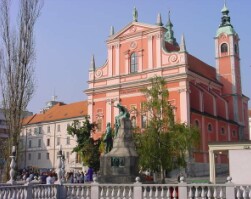
This is the place where several major city streets, and all the cars and people on them, converge. The oldest resident here is the pleasingly rosy Franciscan Church of the Annunciation (1660), with a Francesco Robba altar from 1736. The other buildings here date from after the disastrous 1895 earthquake; among them, two fine Art Nouveau structures, named Urbanc (Centromerkur) and Hauptman. Yet the social if not spatial center of the square is the Prešeren Monument (1905) by Ivan Zajc and Maks Fabiani, which was strongly criticized when first unveiled, especially for flaunting a nude muse so near the church.
 Triple Bridge
Triple Bridge
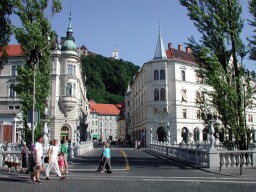
The favorite postcard view of Ljubljana, this brilliantly original structure is also one of Plečnik's greatest masterpieces. Dating from 1931, it basically supplements the old 1842 Špital Bridge with two lateral pedestrian bridges. These are angled southeastward to emphasize how the bridge "funnels" traffic from the various avenues leading into Prešernov trg, and channels it onward through the gates of the Old Town, as represented by the two neo-Renaissance palaces across the river. Crossing the street at either end of the bridge can be tricky, though, so don't stop to admire it till you're safely on the sidelines.
 Old Town
Old Town
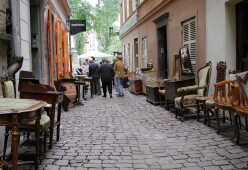
Also known as Old Ljubljana, this term refers to the area on the right bank of the Ljubljanica River, directly beneath Castle Hill, particularly Mestni trg, Stari trg and Gornji trg (links). The only part of central Ljubljana to have survived the 1895 earthquake intact, it has the densest concentration of sights (as well as cafes and bars) in town.
Mestni trg highlights include the Town Hall, or Rotovž (15th century, rebuilt in 1718 by Gregor Maček) with a fine Gothic courtyard; the Robba Fountain (1751), representing the three rivers of Carniola (Ljubljanica, Sava and Krka); and Ribji trg, featuring Ljubljana's oldest house (No. 6, from 1528). The division between Mestni and Stari trg is marked by Plečnik's column-lined Cobbler's Bridge, which is more like a pedestrian zone suspended over water. Stari trg proper begins with the house called Tranča (a former prison). A random pick among the many historic buildings that follow is the Schweiger House at No. 11a.
Heavily atmospheric Gornji trg features Ljubljana's best-preserved medieval houses (Baroque facades notwithstanding), and centers around the Church of St. Florian (1672). Directly adjacent, Levstikov trg was redesigned by Plečnik in 1927. Highlights here include a memorial column dedicated to the Virgin, and the Church of St. James, which has Ljubljana's highest bell tower, an interesting octagonal Jesuit chapel with rich stucco work, and perhaps the finest Baroque church interior in town, including yet another Francesco Robba altar. Across the street stands the vast rococo Gruber Palace (now the national archives), with a fine spiral staircase.
 Ljubljana Castle and Castle Hill
Ljubljana Castle and Castle Hill
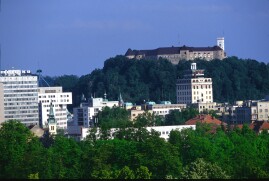
Ljubljana Castle's foundations date back to Celtic times, but what you see today originated after the 1511 earthquake. Highlights here include the older St. George's Chapel (1489) and a 19th century lookout tower. Once it ceased being used as a defensive fortress (in the 17th century), the castle served military, prison, storage and residential purposes. Plečnik dreamed of building a Slovenian Acropolis here, but plans were nixed by the municipal authorities. The restoration job that's been done subsequently (still incomplete) is not to everybody's taste. After descending from the ramparts (Šance), Ljubljana Castle Hill presents you with a dozen forest paths perfect for urban hiking.
 Kongresni trg
Kongresni trg
Also called Zvezda (the Star), this popular downtown park was laid out for the Congress of the Holy Alliance in 1821, on the site of a former moat. Its architectural highlights include the headquarters of Ljubljana University (est.1919) and the newly-restored Academia Philharmonicorum building, home to one of the world's oldest musical societies, founded in 1701. Haydn, Beethoven, Paganini and Brahms were among its honorary members, and Mahler was its resident conductor for one season. But the dominant building here is the Ursuline Church of the Holy Trinity (1726) with a striking facade by an unknown Italian architect.
 National and University Library (NUK)
National and University Library (NUK)
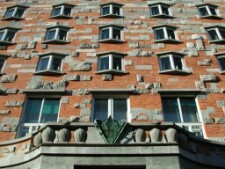
Probably Plečnik's greatest single work in Ljubljana, an extraordinary composition in contrasting textures and bold thematic concepts, NUK was completed in 1941. (Built on the site of a Baroque palace destroyed in the earthquake, it was itself hit by an airplane during the war, but survived.) Entering through massive doors with horse-head handles, a dark marble staircase lined with columns ascends to the library – perhaps a metaphor for the journey towards wisdom. Unfortunately, that's as far as you'll get without a library card. Strolling Vegova Street, with its long row of pillar-propped busts of Slovenian composers and scholars, is some compensation.
 Križanke
Križanke
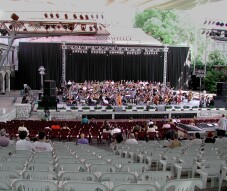
This is the popular name for the former monastery complex of the Teutonic Knights at the southern limits of the city center. It includes an elegant small church by Venetian architect Domenico Rossi (1715). The whole premises were rebuilt by Plečnik in the 1950s, and now serve as an outdoor music stage for several Ljubljana summer festivals. (Try to get a peek at one of the architect's most interesting additions, "Hell Yard".) Immediately adjacent to Križanke is Trg francoske revolucije (French Revolution Square), which contains a Plečnik-designed column commemorating Ljubljana's brief stint as capital of Napoleon's Province of Illyria (1809-13).
 The Roman Wall
The Roman Wall
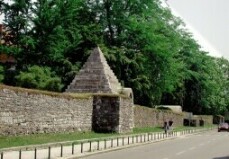
Running for most of the length of Mirje Street, just south of the city center, this is the most extensive of several Roman sites in Ljubljana. (The city was founded by the Romans as Emona in the 1st century AD). This represents, in fact, the entire southern wall of the ancient Roman colonial town, as reconceived in the late 1930s by Plečnik, who added a pyramid and a "lapidarium" for good measure. Today the wall is a favorite practice spot for rock climbers.
 Krakovo
Krakovo
This charming little south-of-center neighborhood was originally a fishermen's settlement, but is best remembered as the "Ljubljana Montmartre", home to Impressionist painter Rihard Jakopič (born at Krakovska 11) and other artists. Its small territory includes some Roman ruins in the Jakopič Garden and plenty of vegetable plots that supply the city's marketplace. Squat, broad-faced peasant-style houses stand separated by small lanes barely wide enough for one-way traffic. The tidy Gradaščica Canal marks the line of division between Krakovo and Trnovo.
 Trnovo
Trnovo
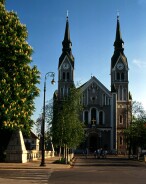
The biggest historical landmark in the mostly modern residential suburb of Trnovo is the elegant Church of St. John The Baptist (seen today in its post-earthquake guise), where the most famous event in Slovenian literary history took place. A Plečnik bridge dating from 1932, incorporating pyramids, statues and even trees, crosses towards it over the Gradaščica Canal. Further down the street to the left of the church are the house where Plečnik lived (now a museum exhibit) and the KUD France Prešeren cultural center. Trnovo is also home to Slovenia's biggest rap star, Klemen Klemen.
 Miklošičeva Street
Miklošičeva Street
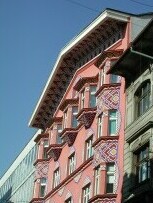
This important downtown street is no more than a hundred years old, having been planned as a major extension of city limits following the 1895 earthquake. It may be viewed as a grand procession of early modern architecture (though it's you that's marching, of course). Among the Art Nouveau highlights are elegant Hotel Union and the recently restored People's Loan Bank (both by Josip Vancaš)and, further up the road, Fabiani's Miklošič Park (1902). There's also Ivan and Helena Vurnik's boldly folk-patterned Cooperative Bank (1922), as well as buildings by other famous Ljubljana architects like Šubic and Plečnik.
 Nebotičnik
Nebotičnik
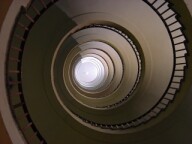
The principal tourist sight in the newer, largely pragmatic section of downtown Ljubljana centering on Slovenska Street, the "Skyscraper" was built in 1933 for the Pension Insurance Fund by architect Vladimir Šubic. Deplored at the time as a "punch in the eye for Baroque Ljubljana", it now seems a rather quaint Old World take on modern American architecture. The building features a vertiginous spiral staircase; but even if you do make it all the way up, you'll find the rooftop cafe and observation deck closed these days, allegedly because of the frequent occurrence of suicide leaps.
 National Museum and National Gallery
National Museum and National Gallery
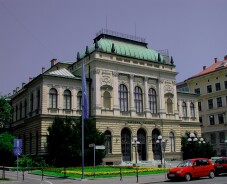
Ljubljana's two most high-profile museums are housed in suitably grand buildings. The Rudolfinum (1885) is home to the National Museum, Ljubljana's oldest museum, founded in 1821. Featuring large permanent displays on archeology, ethnography and Slovenian history, it also puts on important temporary exhibitions. The typical Habsburg-era Narodni Dom (1896) a few blocks away houses the National Gallery. Its unrivalled display of Slovenian painting and sculpture from the Baroque to the late 19th century is already on view, and the nearly-completed new wing will shelter an impressive collection of European masters.
 Tivoli Park
Tivoli Park
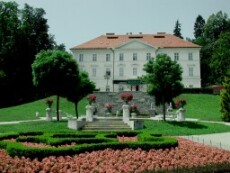
Generously out of proportion to the city as a whole, Tivoli is a small green world right within its limits. A long promenade paced out by Plečnik lampposts (their glass globes invariably shattered) leads the way to Tivoli Mansion, with its notorious guard dog statues. First built in the 17th century, it's been home to Jesuits, bishops and an Austrian field marshal, and currently shelters the International Center for Graphic Arts. Also in the park are the Museum of Modern History, a recreation center and a major music venue. Continue walking through the forest, as far as the Rožnik Hill church or Ljubljana Zoo.

 Message Boards - Contact Us
Message Boards - Contact Us

 Message Boards - Contact Us
Message Boards - Contact Us
![]()